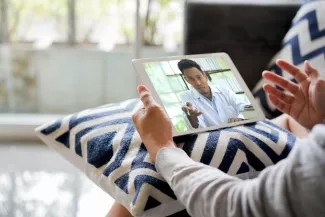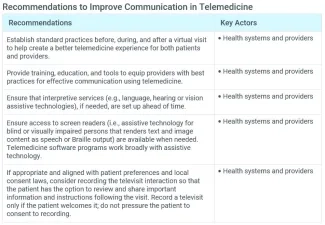Why It Matters
“It’s important for providers to not only be equipped (either themselves or other staff) to handle technical issues that may arise during televisits, but also to have a good ‘webside manner.’”
Image

In 2020, not long after the start of the COVID-19 pandemic, IHI convened an expert panel to discuss the current state of telehealth, consider the critical components of safe, equitable, and person-centered telemedicine, and identify recommendations for improving the quality of virtual care. The culmination of those discussions was a framework for ensuring safe, equitable, person-centered telemedicine that includes six elements: access, privacy, diagnostic accuracy, communication, psychological and emotional safety, and human factors and system design. The following is an excerpt from the Telemedicine: Ensuring Safe, Equitable, Person-Centered Virtual Care white paper focused on communication.
Telemedicine requires provider training on specific communication tactics. Fortunately, with proper training and preparation, it is possible to communicate effectively via virtual modalities. One communication challenge involves technical hurdles or glitches — for example, when the quality of the televisit video or audio is low or uneven, or the patient has difficulty connecting to the telemedicine services. Technical challenges potentially contribute to inequities since low-income individuals are more likely to have inadequate infrastructure to support televisits. Also, patients with certain disabilities (e.g., vision, hearing) may face additional communication challenges with telemedicine. For patients who speak various languages, virtual communication can add another layer of difficulty in understanding or in being understood. There are also emotional and psychological communication challenges to consider when using telemedicine. It can be more difficult for a provider to establish a rapport with the patient during a virtual visit. Without in-person proximity, people may be less able to pick up on subtle cues in facial expressions and body language. Technology as the medium for interaction can feel cold and distant.
For some patients, however, telemedicine may provide an opportunity for greater psychological safety and thus enhance rapport and communication. As discussed above, some patients may feel more comfortable in their own home than in a medical setting. The provider and the patient can establish a connection using telemedicine before the patient presents for an in-person visit to a clinical setting. In addition, some providers report that patients feel they have more of the provider’s attention during a virtual visit because the provider is often focusing on a computer screen during in-person visits in a clinical setting. It’s important for providers to not only be equipped (either themselves or other staff) to handle technical issues that may arise during televisits, but also to have a good “webside manner.”
Image

Training may be needed to help providers appropriately adapt their manner for telemedicine. Some health care systems offer providers simple guidance for communicating via telemedicine. For example, Penn Medicine developed a provider “pocket note” as important preparation and communication prompts for virtual visits with patients.
Image

You may also be interested in:
